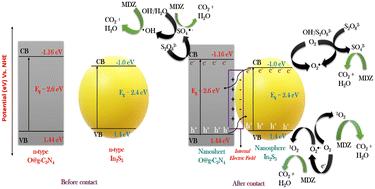当前位置:
X-MOL 学术
›
Environ. Sci.: Nano
›
论文详情
Our official English website, www.x-mol.net, welcomes your
feedback! (Note: you will need to create a separate account there.)
Bandgap-engineered In2S3 quantum dots anchored on oxygen-doped g-C3N4: forging a dynamic n–n heterojunction for enhanced persulfate activation and degradation of metronidazole
Environmental Science: Nano ( IF 5.8 ) Pub Date : 2024-11-20 , DOI: 10.1039/d4en00859f Soumya Ranjan Mishra, Vishal Gadore, Saptarshi Roy, Md. Ahmaruzzaman
Environmental Science: Nano ( IF 5.8 ) Pub Date : 2024-11-20 , DOI: 10.1039/d4en00859f Soumya Ranjan Mishra, Vishal Gadore, Saptarshi Roy, Md. Ahmaruzzaman

|
Herein, an ultrasonication approach was used to anchor In2S3 quantum dots (QDs) onto oxygen-doped graphitic carbon nitride (O@g-C3N4), resulting in a novel heterojunction catalyst. Characterization techniques validated the successful incorporation of In2S3 into the O@g-C3N4 matrix, with transmission electron microscopy (TEM) indicating the existence of In2S3 QDs measuring 6.62 nm. The photocatalyst (0.24 g L−1) effectively degraded 15 mg L−1 of metronidazole (MDZ) via persulfate (PS) activation under visible light irradiation, with a degradation efficiency of 98.17 ± 1.53% in 25 min. This improved performance was due to the creation of an n–n heterojunction, in which the Fermi energy levels of O@g-C3N4 and In2S3 reached equilibrium, resulting in an internal electrostatic field at their interface that enabled efficient carrier transfer. Combining trapping tests with a well-established S-scheme charge transfer mechanism indicated an excellent photocatalytic process for the In2S3/O@g-C3N4 heterojunction. Chemical oxygen demand (COD) and total organic carbon (TOC) studies were used to measure the photocatalyst's efficacy in degrading MDZ, while its capacity to degrade other pollutants was also tested. Furthermore, after seven cycles, the catalyst displayed remarkable reusability and maintained efficiency in various water conditions with coexisting species such as cations, anions, and organic compounds. As a result, the discovered In2S3/O@g-C3N4 heterojunction catalyst shows significant promise for the effective and long-term removal of MDZ and other toxic pollutants from water, paving the way for enhanced water treatment technologies.
中文翻译:

锚定在氧掺杂 g-C3N4 上的带隙工程 In2S3 量子点:形成动态 n-n 异质结,以增强甲硝唑的过硫酸盐活化和降解
在此,使用超声方法将 In2S3 量子点 (QD) 锚定在氧掺杂石墨氮化碳 (O@g-C3N4) 上,从而产生一种新型异质结催化剂。表征技术验证了 In2S3 成功掺入 O@g-C3N4 基质中,透射电子显微镜 (TEM) 表明存在尺寸为 6.62 nm 的 In2S3 QD。光催化剂 (0.24 g L-1) 在可见光照射下通过过硫酸盐 (PS) 活化有效降解了 15 mg L-1 甲硝唑 (MDZ),在 25 分钟内降解效率为 98.17 ± 1.53%。这种性能的提高是由于产生了 n-n 异质结,其中 O@g-C3N4 和 In2S3 的费米能级达到平衡,从而在它们的界面处产生内部静电场,从而实现高效的载流子转移。将捕获测试与成熟的 S 型电荷转移机制相结合,表明 In2S3/O@g-C3N4 异质结具有出色的光催化过程。化学需氧量 (COD) 和总有机碳 (TOC) 研究用于测量光催化剂降解 MDZ 的功效,同时还测试了其降解其他污染物的能力。 此外,经过 7 次循环后,催化剂表现出卓越的可重复使用性,并在各种水条件下与阳离子、阴离子和有机化合物等共存物质保持高效。因此,发现的 In2S3/O@g-C3N4 异质结催化剂在有效和长期去除水中 MDZ 和其他有毒污染物方面显示出巨大的前景,为增强水处理技术铺平了道路。
更新日期:2024-11-20
中文翻译:

锚定在氧掺杂 g-C3N4 上的带隙工程 In2S3 量子点:形成动态 n-n 异质结,以增强甲硝唑的过硫酸盐活化和降解
在此,使用超声方法将 In2S3 量子点 (QD) 锚定在氧掺杂石墨氮化碳 (O@g-C3N4) 上,从而产生一种新型异质结催化剂。表征技术验证了 In2S3 成功掺入 O@g-C3N4 基质中,透射电子显微镜 (TEM) 表明存在尺寸为 6.62 nm 的 In2S3 QD。光催化剂 (0.24 g L-1) 在可见光照射下通过过硫酸盐 (PS) 活化有效降解了 15 mg L-1 甲硝唑 (MDZ),在 25 分钟内降解效率为 98.17 ± 1.53%。这种性能的提高是由于产生了 n-n 异质结,其中 O@g-C3N4 和 In2S3 的费米能级达到平衡,从而在它们的界面处产生内部静电场,从而实现高效的载流子转移。将捕获测试与成熟的 S 型电荷转移机制相结合,表明 In2S3/O@g-C3N4 异质结具有出色的光催化过程。化学需氧量 (COD) 和总有机碳 (TOC) 研究用于测量光催化剂降解 MDZ 的功效,同时还测试了其降解其他污染物的能力。 此外,经过 7 次循环后,催化剂表现出卓越的可重复使用性,并在各种水条件下与阳离子、阴离子和有机化合物等共存物质保持高效。因此,发现的 In2S3/O@g-C3N4 异质结催化剂在有效和长期去除水中 MDZ 和其他有毒污染物方面显示出巨大的前景,为增强水处理技术铺平了道路。






























 京公网安备 11010802027423号
京公网安备 11010802027423号